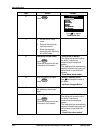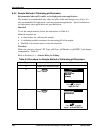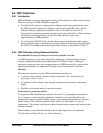
Input Calibration
January 2009 UDA2182 Universal Dual Analyzer Product Manual 151
8.6 ORP Calibration
8.6.1 Introduction
ORP calibration consists of adjusting the reading of the analyzer to match a known value.
There are two types of ORP calibration supported:
• To calibrate the system to compensate for changes in electrode potentials over time,
the ORP electrode is placed in a reference solution of known ORP value, and the
analyzer reading is adjusted to match this value, as described in Section 8.6.
Instructions for preparing standard solutions are also provided below. These solutions
are stable for only short periods of time (less than 8 hours) and are only
approximations of ORP potentials.
• To calibrate the UDA2182 only, not the whole system including electrodes, apply a
known millivolt signal to the Analyzer instead of input from the electrode, then adjust
the UDA2182 reading to match the actual millivolt input, as described in Table 8-7.
8.6.2 ORP Calibration Using Reference Solution
Recommended to adjust for changes in electrode potential over time
An ORP measuring system can be checked by measuring a solution having a known
oxidation-reduction potential, then adjusting the UDA2182 to match. Although a
reference solution provides only an approximation of ORP potential, the system can be
adjusted periodically to compensate for changes in electrode potential over time.
Materials
The materials required to use the ORP standardization method are:
• A solution with a known oxidation-reduction potential. (See “Instructions for
preparing solution” below.
• A container for the solution, large enough to immerse the electrode to measuring
depth.
• Distilled or de-ionized water to rinse the electrode.
Instructions for preparing solution
To prepare an ORP standardization solution, dissolve 0.1 g of quinhydrone powder in
5 cc of acetone or methyl alcohol (methanol). Add this to not more than 500 cc of a
standard pH reference solution (buffer), about 1 part saturated quinhydrone to 100 parts
buffer solution. The oxidation potential of this solution is listed below for several
temperatures. The polarity sign shown is that of the measuring element with respect to the
reference element.
These solutions are unstable and should be used within eight hours of preparation.
All mV values in Table 8-5 have a
± 30 mV tolerance.


















